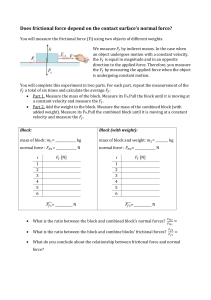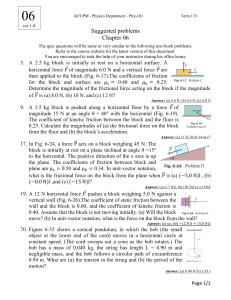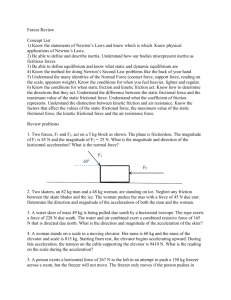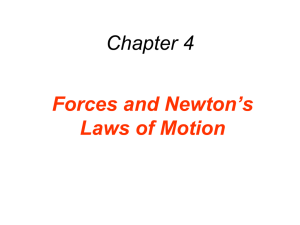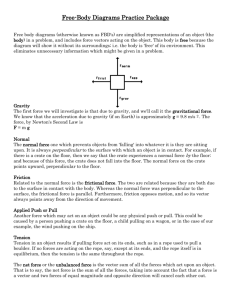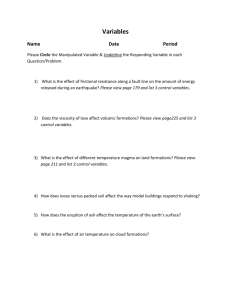Lab3_Friction (donot print)
advertisement
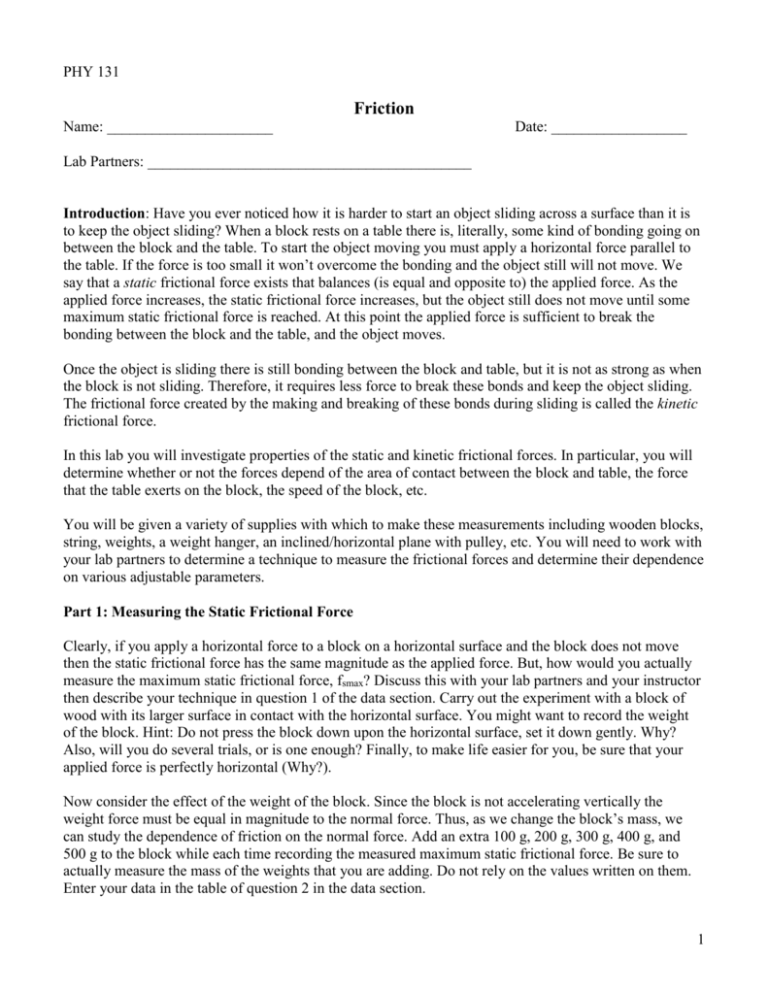
PHY 131 Friction Name: ______________________ Date: __________________ Lab Partners: ___________________________________________ Introduction: Have you ever noticed how it is harder to start an object sliding across a surface than it is to keep the object sliding? When a block rests on a table there is, literally, some kind of bonding going on between the block and the table. To start the object moving you must apply a horizontal force parallel to the table. If the force is too small it won’t overcome the bonding and the object still will not move. We say that a static frictional force exists that balances (is equal and opposite to) the applied force. As the applied force increases, the static frictional force increases, but the object still does not move until some maximum static frictional force is reached. At this point the applied force is sufficient to break the bonding between the block and the table, and the object moves. Once the object is sliding there is still bonding between the block and table, but it is not as strong as when the block is not sliding. Therefore, it requires less force to break these bonds and keep the object sliding. The frictional force created by the making and breaking of these bonds during sliding is called the kinetic frictional force. In this lab you will investigate properties of the static and kinetic frictional forces. In particular, you will determine whether or not the forces depend of the area of contact between the block and table, the force that the table exerts on the block, the speed of the block, etc. You will be given a variety of supplies with which to make these measurements including wooden blocks, string, weights, a weight hanger, an inclined/horizontal plane with pulley, etc. You will need to work with your lab partners to determine a technique to measure the frictional forces and determine their dependence on various adjustable parameters. Part 1: Measuring the Static Frictional Force Clearly, if you apply a horizontal force to a block on a horizontal surface and the block does not move then the static frictional force has the same magnitude as the applied force. But, how would you actually measure the maximum static frictional force, fsmax? Discuss this with your lab partners and your instructor then describe your technique in question 1 of the data section. Carry out the experiment with a block of wood with its larger surface in contact with the horizontal surface. You might want to record the weight of the block. Hint: Do not press the block down upon the horizontal surface, set it down gently. Why? Also, will you do several trials, or is one enough? Finally, to make life easier for you, be sure that your applied force is perfectly horizontal (Why?). Now consider the effect of the weight of the block. Since the block is not accelerating vertically the weight force must be equal in magnitude to the normal force. Thus, as we change the block’s mass, we can study the dependence of friction on the normal force. Add an extra 100 g, 200 g, 300 g, 400 g, and 500 g to the block while each time recording the measured maximum static frictional force. Be sure to actually measure the mass of the weights that you are adding. Do not rely on the values written on them. Enter your data in the table of question 2 in the data section. 1 Now, after removing the weights from the block, flip the block over on its side so that a smaller area is in contact with the horizontal surface. Repeat the measurements that you did previously, adding weights, to determine the maximum static frictional force. Enter your data in question 3 of the data section. Part 2: Measuring the Kinetic Frictional Force Now you need to come up with a technique to measure the kinetic frictional force. You will need to figure out a way to apply a known force so the block slides and either make sure the block’s acceleration is zero so the kinetic frictional force balances the applied force, or figure out a way to measure the acceleration so that you can use Newton’s second law to calculate the frictional force. I would recommend the former technique. Describe your technique (after you figure out something that works) in question 7 of the data section. Add mass to the block, as you did previously, to increase the normal force and measure the kinetic frictional force. Enter your data in question 8 of the data section. Part 3: Block on an inclined plane. Place the block on an inclined plane initially set at zero degrees. Do not apply any horizontal forces. Slowly increase the angle of the inclined plane until the block slides. Record this angle and then reduce the angle slightly, place the block back on the inclined plane and verify that the block again slides at the previously recorded angle. You may need to take several trials to determine the precise angle at which the block slides. How could you use this angle to determine the dependence of the maximum static frictional force on the normal force? Answer this question in question 12 of the data section. You might want to wait until your analysis of the part 1 is finished. Is there an angle that is less than the angle previously measured such that if the block is given a slight nudge, it slides down the incline with constant velocity? Determine this angle and discuss how it can be used to determine the dependence of the kinetic frictional force on the normal force. See question 13 of the data section. Data and answers to questions: 1. Describe your technique to measure the maximum static frictional force. 2 2. Data for dependence of maximum frictional force on normal force with large surface of block facing down. Total mass (block plus masses) Normal Force Mass of hanger plus masses fsmax 3. Data for dependence of maximum frictional force on normal force with block on its side. Total mass (block plus masses) Normal Force Mass of hanger plus masses fsmax 4. Based on your results, does the maximum static frictional force depend on the normal force? What kind of function would best fit your data (e.g. linear, quadratic)? Hint: Plot a graph. Clearly if there is zero normal force (i.e. the block is not touching the horizontal surface) there would be zero static frictional force. Thus, include the point (0,0) in your data when you make a graph. What is the equation from this graph? 5. Does the maximum static frictional force depend on the surface area? ______________________ (Hint: Plot a graph using your data from 2) and 3) above to answer this question.) 3 6. From your measurements and analysis, and your understanding of the maximum static frictional force, can you come up with an equation that describes how fsmax depends on the normal force? Hint: Is fsmax proportional to the normal force? Is fsmax proportional to the normal force squared? etc. ______________________________________________________ What is the proportionality constant? What are its units? Does the proportionality constant make sense in terms of the materials of the block and horizontal surface? Explain. 7. Describe your technique to measure the kinetic frictional force. 4 8. Data for dependence of kinetic frictional force on normal force with large surface of block facing down. Total mass (block plus masses) Normal Force Mass of hanger plus masses fk 9. Based on your results, does the kinetic frictional force depend on the normal force? Explain. What kind of function would best fit your data (e.g. linear, quadratic)? Hint: Plot a graph. Clearly if there is zero normal force (i.e. the block is not touching the horizontal surface) there would be zero kinetic frictional force. Thus, include the point (0,0) in your data when you make a graph. What is the equation from this graph? 10. From your measurements and analysis, and your understanding of the kinetic frictional force, can you come up with an equation that describes how fk depends on the normal force? Hint: Is fk proportional to the normal force? Is fk proportional to the normal force squared? etc. _____________________________________________________ What is the proportionality constant? What are its units? Does the proportionality constant make sense in terms of the materials of the block and horizontal surface? Explain 5 11. How do the proportionality constants compare for kinetic friction and maximum static friction? Explain. Why do you think they are this way? Explain in terms of microscopic surface irregularities. 12. Suppose you placed the block on an inclined plane and increased the angle until the block slid with constant velocity after giving it a nudge. How could you use this angle to determine the proportionality constant for the equation relating the kinetic frictional force to the normal force? Do the calculations with a free body diagram to come up with an equation for the proportionality constant in terms of the angle of incline, . 6


